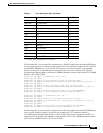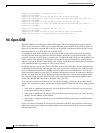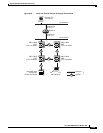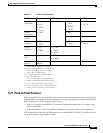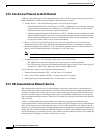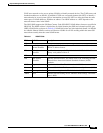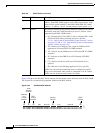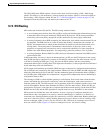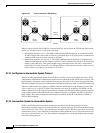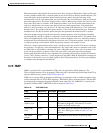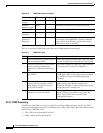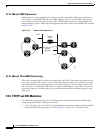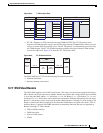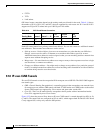
9-31
Cisco ONS 15600 Reference Manual, R7.2
Chapter 9 Management Network Connectivity
9.7.4 OSI Routing
The ONS 15600 main NSAP address is shown on the node view Provisioning > OSI > Main Setup
subtab. This address is also the Router 1 primary manual area address, which is viewed and edited on
Provisioning > OSI > Routers subtab. See the “9.7.7 OSI Virtual Routers” section on page 9-37 for
information about the OSI router and manual area addresses in CTC.
9.7.4 OSI Routing
OSI architecture includes ESs and ISs. The OSI routing scheme includes:
•
A set of routing protocols that allow ESs and ISs to collect and distribute the information necessary
to determine routes. Protocols include the ES-IS and IS-IS protocols. ES-IS routing establishes
connectivity and reach ability among ESs and ISs attached to the same (single) subnetwork.
•
A routing information base (RIB) containing this information, from which routes between ESs can
be computed. The RIB consists of a table of entries that identify a destination (for example, an
NSAP), the subnetwork over which packets should be forwarded to reach that destination, and a
routing metric. The routing metric communicates characteristics of the route (such as delay
properties or expected error rate) that are used to evaluate the suitability of a route compared to
another route with different properties, for transporting a particular packet or class of packets.
•
A routing algorithm, Shortest Path First (SPF), that uses information contained in the RIB to derive
routes between ESs.
In OSI networking, discovery is based on announcements. An ES uses the ES-IS protocol end system
hello (ESH) message to announce its presence to ISs and ESs connected to the same network. Any ES
or IS that is listening for ESHs gets a copy. ISs store the NSAP address and the corresponding
subnetwork address pair in routing tables. ESs might store the address, or they might wait to be informed
by ISs when they need such information.
An IS composes intermediate system hello (ISH) messages to announce its configuration information to
ISs and ESs that are connected to the same broadcast subnetwork. Like the ESHs, the ISH contains the
addressing information for the IS (the NET and the subnetwork point-of-attachment address [SNPA])
and a holding time. ISHs might also communicate a suggested ES configuration time recommending a
configuration timer to ESs.
The exchange of ISHs is called neighbor greeting or initialization. Each router learns about the other
routers with which they share direct connectivity. After the initialization, each router constructs a
link-state packet (LSP). The LSP contains a list of the names of the IS’s neighbors and the cost to reach
each of the neighbors. Routers then distribute the LSPs to all of the other routers. When all LSPs are
propagated to all routers, each router has a complete map of the network topology (in the form of LSPs).
Routers use the LSPs and the SPF algorithm to compute routes to every destination in the network.
OSI networks are divided into areas and domains. An area is a group of contiguous networks and
attached hosts that is designated as an area by a network administrator. A domain is a collection of
connected areas. Routing domains provide full connectivity to all ESs within them. Routing within the
same area is known as Level 1 routing. Routing between two areas is known as Level 2 routing. LSPs
that are exchanged within a Level 1 area are called L1 LSPs. LSPs that are exchanged across Level 2
areas are called L2 LSPs. Figure 9-21 shows an example of Level 1 and Level 2 routing.



